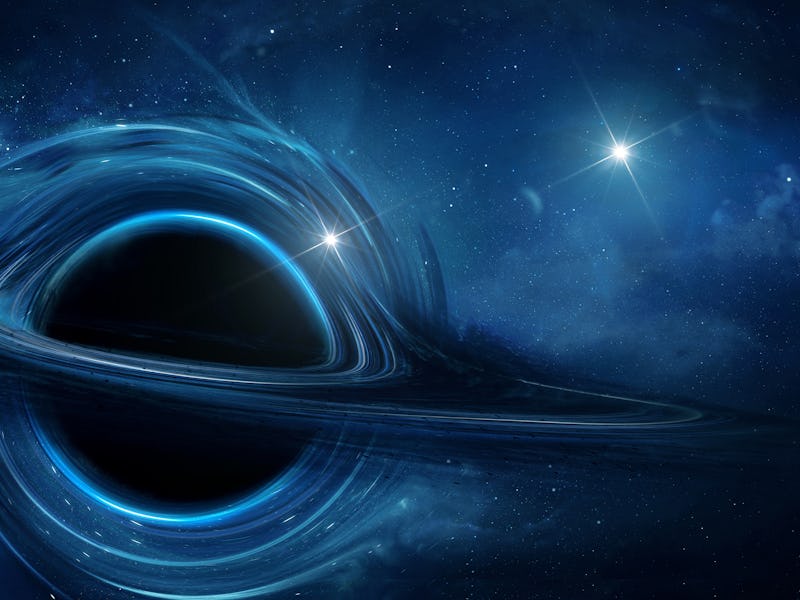Astronomers find a puzzling black hole spinning sideways
It may have gotten a slight kick while being formed.

Not all black holes are born equal, and some were cursed with cosmic misfortunes since their formation.
Astronomers recently discovered a misaligned black hole spinning off of its axis by about 40 degrees. This is the first time scientists have observed such unusual behavior from a black hole, and they believe it may be due to a slight kick it received after its birth.
The discovery is detailed in a study published Thursday in the journal Science.
WHAT’S NEW — Juri Poutanen, an astronomy professor at Nordic Institute for Theoretical Physics and lead author of the study, began observing the black hole MAXI J1820+070 back in 2019 when he noticed that the radiation emitted from this object was extremely polarized.
“We have never seen anything like that,” Poutanen tells Inverse.“It means that if it's strongly polarized, then there is a big break of the symmetry in the system.”
X-ray binary systems involve a black hole and a companion star, each orbiting around one another while spinning on their individual axes. Their rotation tends to be aligned with each other while being perpendicular to their orbital plane.
When these two objects get closer to one another through their gravitational pull, the black hole will suck material from its companion star. That material will form an accretion disk around the black hole, which emits radiation.
Some of that material escapes the abyss of the black hole, and ends up falling onto the boundary surrounding the black hole, also known as the event horizon, before shooting out in the form of two powerful jets of plasma.
Illustration of a black hole binary system, where the black hole siphons gases off a nearby star.
The jets are two short beams of material being emitted from the event horizon, and therefore serve as an indication of the black hole’s spin on its axis.
The team behind the new study gathered data about the jets’ inclination, position, and angle, and created a three-dimensional orientations of the jets.
But they ran into a problem: the jets were emitting material that was at least 40 degrees away from each other. This is the biggest offset ever observed in an X-ray binary system.
Why is the black hole misaligned?
This may have something to do with its birth.Black holes are compact regions of space with gravitational pulls so strong that nothing can escape their influence, not even light itself.
Some black holes are formed in the aftermath of the death of a star.Aafter a star runs out of fuel and collapses under the weight of its own gravity, it explodes in a powerful supernova, which often leaves behind a black hole in its place.
“The only reasonable explanation is that the misalignment was formed when the black hole was formed,” Poutanen says.
Following the death of a massive star, a so-called neutrino rocket shot out. Neutrinos are subatomic particles similar to electrons, with a much smaller mass.
“The neutrino rocket was ejected in one direction more than the other,” Poutanen says.
That neutrino rocket kicked the black hole in one direction, which disrupted the alignment of the system.
WHAT’S NEXT — The astronomers behind the recent observations want to see more of this reported misalignment in other systems before they can know for sure what causes it.
They are hoping to use NASA’s recently launched Imaging X-Ray Polarimetry Explorer (IXPE), a space observatory that will observe the most extreme objects in space in X-ray, to observe the binary system and others like it.
“It can observe X-ray polarization, and measure the symmetry in the system,” Poutanen says.
Poutanen believes that black holes’ misalignment could help explain other observational data of black holes where some phenomenon of these cosmic beasts are left unexplained.
“So now if we do have misalignment and we observe it then these models actually have a good support because before it was just theoretical imagination,” Poutanen says. “If we assume that we have misalignment, then maybe it’s not so crazy.”
Abstract — The observational signatures of black holes in x-ray binary systems depend on their masses, spins, accretion rate and the misalignment angle between the black hole spin and the orbital angular momentum. We present optical polarimetric observations of the black hole x-ray binary MAXI J1820+070, from which we constrain the position angle of the binary orbital axis. Combining this with previous determinations of the relativistic jet orientation axis, which traces the black hole spin, and the inclination of the orbit, we determine a lower limit of on the spin-orbit misalignment angle. The misalignment must originate from either the binary evolution or black hole formation stages. If other x-ray binaries have similarly large misalignments, it would bias measurements of black hole masses and spins using x-ray observations.
This article was originally published on